“Like the Scenes of Some Hideous Dream”: Lewis Powell’s Assassination Attempt on Secretary of State Seward
Almost every American is familiar with the incident that unfolded on the night of April 14, 1865, at Ford’s Theatre. However, many individuals are probably less familiar with the brutal attack that unfolded a mere six blocks away at the Seward residence around the same time Lincoln was shot by John Wilkes Booth. Both events left Washington’s citizens – and later the rest of the country – filled with raged, overcome with hysteria, and reeling in grief. Only days before, the country had been jubilantly celebrating the news of Lee’s surrender to Grant at Appomattox.[1]
Knife-Wielding Madman
On April 14, around 10 p.m. a tall, well-dressed man rang at the door of Secretary of State William H. Seward’s home located in Lafayette Square. Seward’s servant, William Bell, answered. The unexpected visitor explained that Dr. Tullio S. Verdi, the Seward family physician, had sent him with a prescription for the Secretary of State. Seward had fractured his lowered jaw and right arm during a carriage accident on April 5. He remained bedridden and in agony ever since the mishap.[2]
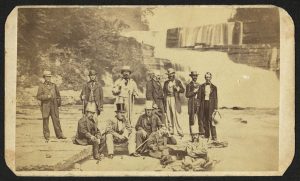
The man proceeded up the stairs toward Steward’s bedroom, when he was confronted by Seward’s son, 34-year-old Assistant Secretary of State Frederick W. Seward. Frederick informed the visitor that his father was asleep and should not be disturbed. The man would not budge. After a short exchange, the man yielded to Frederick and proceeded back down the stairs. “[L]ike the scenes of some hideous dream, came the bloody incidents of the night,” Fredrick later recalled. The man made it down a couple of stairs before spinning around. He drew an 1858 Whitney Navy revolver, pointed it at Frederick Seward and pulled the trigger.[3]
The armed intruder was Lewis Thornton Powell (also known as Lewis Payne), an ex-Confederate soldier of the 2nd Florida Infantry who was wounded in the wrist at Gettysburg. On the evening of April 14, he was acting as John Wilkes Booth’s co-conspirator and had come to murder Secretary of State Seward.[4]
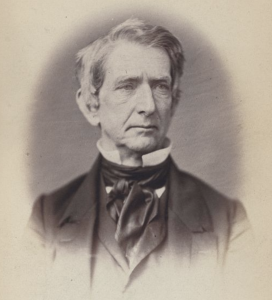
Fortunately for Frederick Seward, Powell’s revolver misfired. But the powerful, 6-foot-tall Powell struck him numerous times on the head, hitting him so hard that he broke the Whitney revolver. Frederick collapsed to the floor.[5]
The ruckus on the other side of William H. Seward’s bedroom door alerted his nurse, George Foster Robinson, and his 20-year-old daughter Fanny. Robinson, a sergeant in the 8th Maine Regiment, had been wounded in the right leg by a canister shot at Bermuda Hundred in May 1864. While recovering, Robinson was assigned to look after William H. Seward following his carriage accident. As Robinson opened the door to investigate, Powell shoved his way into the room. Clenching a Bowie knife in his right hand, he slashed Robinson in the head, knocking him to the floor. The intruder scurried past Fanny Seward and lunged at the sleeping Secretary of War. Powell proceeded to stab him in the neck and face.[6]

Robinson jumped to Seward’s rescue, dragging the crazed assassin from his bedside. In the process of Powell’s frenzied attack, William Seward fell to the opposite side of the bed out of Powell’s reach. As Powell and Robinson tussled, Fanny Seward raced out of the room in a panic. She encountered her mother Frances and sister-in-law Anna, both who demanded to know what was going on.[7]
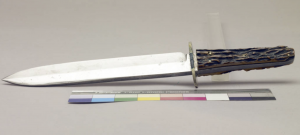
Back in William Seward’s room, Powell repeatedly thrust his knife into the Maine soldier’s shoulder. Once he broke free, Powell fled down the stairs and into the street, but not before striking William Seward’s oldest son, 38-year-old Major Augustus H. Seward, on the head and gashing his right hand, and stabbing War Department messenger Emrick W. Hansell, who been staying the night in the Seward home, in the back. Powell then mounted his horse and rode off into the night.[8]
“A Most Horrible Deed”
“Five minutes later,” Frederick Seward recalled, “the aroused household was gazing, horrified, at the bleeding faces and figures in their midst.” The first thing Fanny Seward remembered seeing was her brother Augustus’ head covered with blood. “It seemed to that every man I met had blood on his face,” she wrote in her diary. “Father looked so ghastly I was sure he was dead,” she stated, “he was white & very thin with the blood that had drained from the gashes about his face & throat.” Despite being wounded himself, Robinson directed Fanny to help slow her father’s blood loss by applying cloth rags and cold water to his wounds.[9]
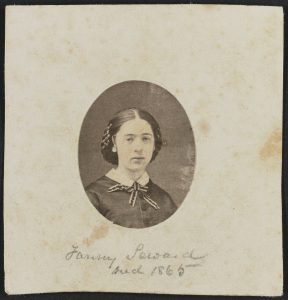
Dr. Verdi hurried to Seward’s home after William Butler alerted him of Powell’s attack. The doctor grabbed his surgical case and rushed two blocks to the crime scene. Frances Seward asked him to attend to her lifeless husband first. “I had left Mr. Seward about nine o‘clock very comfortable in his room,” Verdi stated, “and when I saw him next be was in his bed covered with blood, with blood all around him, blood under the bed, blood on the handles of the doors.” He looked like “an exsanguinated corpse” as blood oozed from the gash in his cheek. The flap of skin hung loose on his neck. “The gash commenced from the high cheek bone down to the neck, in a semi-circular form, towards the mouth,” Verdi noted of the cut, “it was, probably, five inches long and two inches deep. It was a frightful wound.” On further examination, he found another stab wound under Seward’s left ear. Luckily, Powell had missed his carotid artery and jugular vein. Seward had lost much blood, but Verdi concluded he would live.[10]
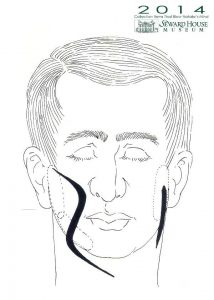
Verdi next attended to Frederick Seward in an adjacent room. “He had a ghastly appearance, was unable to articulate, gave me a smile of recognition, and pointed to his head,” Verdi recalled. “There I found a large wound a little above the forehead and somewhat on the left of the median line, and another further back, on the same side. The cranium had been crushed in both places, and the brain was exposed.” Roughly an hour after his wounds were dressed, Frederick fell into a coma, which he remained for 60 hours.[11]
Sergeant Robinson had suffered four wounds during his struggle with Powell. Verdi concluded that the soldier’s shoulder bone had prevented Powell’s knife from penetrating his chest and killing him. As for Hansell, Verdi found him withering in pain on a bed in another room. The messenger had received a stab wound nearly three inches deep and an inch wide in his back near the spine. Augustus Seward appeared to have sustained the least serious wounds of the five men. Verdi reported that he suffered one “from a blow with the butt-end of a pistol, on the upper and middle part of the forehead; the other a cut over the metacarpal bone of the thumb of his right hand.”[12]
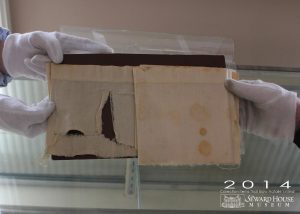
As the men and women sat stunned from the attack, Surgeon General James K. Barnes arrived at the Seward home and reported that President Lincoln had been shot at Ford’s Theatre, adding to their gloom.[13]
“On the Brink of His Grave”
The press falsely reported that William H. Seward and his son Frederick had been killed during the attack. One newspaper pessimistically reported that he “rests on the brink of the grave.” For days his life hung in the balance, but he made a full recovery. By April 25, he was able to walk from his room to visit Augustus.[14]

Frederick was in worse shape than his father. “The slightest unfavorable turn may end his life,” his brother Brigadier General William H. Seward, Jr. concluded in a letter to his wife Janet on April 20, 1865. “[H]e may remain in this condition for one or two weeks yet I do not even think that his chances are equal.”[15]
On April 25, five surgeons examined Frederick’s injuries. The doctors feared he was still too weak to perform surgery without taking the chance of risking death, so they left the decision in the hands of the family. “Mother & Fanny were at first opposed but at last they and Anna decided to leave the matter for my decision,” William Seward, Jr. explained to his wife. “I at once decided that it should be done for I felt that there was no hope for him as he was. After this you may imagine with what anxiety I watched for the result.” Three pieces of bone about the size of a thumbnail (pressing on his brain and piercing an artery) were extracted. Frederick slowly improved, but the family continually worried that he could relapse at a moment’s notice.[16]
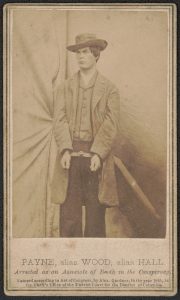
William’s and Frederick’s conditions stressed the entire family, hitting Frances and Fanny the hardest. For roughly a week, neither slept more than two hours each night. Despite complaining of “neuralgia and nausea” Frances sat for an hour each morning and evening by her boy’s bedside. “His pale, patient face is never out of my mind,” she admitted in a letter to her sister Lazette. William Seward worried about the toll it was taking on her. “His mother seems to darken under her anxieties,” he wrote. “I am disturbed about her with every check…” Her health took a turn for the worse and she died on June 21, 1865, followed by Fanny 16 months later.[17]
Justice for the Victims?
Lewis Powell was arrested at Mary Surratt’s boarding home three days after the assassination attempt on William H. Seward. Brigadier General Martin D. Hardin and Dr. Verdi escorted Augustus and Fanny to the USS Saugus, where they identified Powell. He was executed, alongside Mary Surratt, David Herold, and George Atzerodt, on July 7, 1865. In November 1994, Powell’s great-grandniece interred his skull, formally in the possession of the Smithsonian, at Geneva Cemetery, located in Florida.[18]

Interestingly, General William H. Seward, Jr. forwarded some unusual keepsakes related to his father’s attempted murder to his wife. “I enclose herein an excellent photograph of Fred, and two of the villain who tried to kill him & father also one of Booth, these two latter have been suppressed by order of the War Dept but a friend of mine gave them to me,” he wrote to her on May 13. “Show them as much as you like but do not allow any copies to be made of them.”[19]
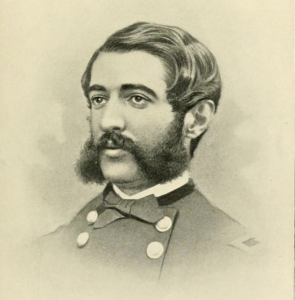
Everyone present at the Seward house on the night of Powell’s attack suffered physical or emotional (or both) injuries as a result. Still, the tragic event is a mere footnote in the greater narrative of Lincoln’s assassination. While there is an NPS site dedicated to Lincoln’s assassination, only a small bronze plaque marks the spot where Powell carried out his crime at the Seward residence on the memorable night of April 14, 1865.[20]
Note: The Seward House Museum located in Auburn, New York, has an exhibit and some fascinating artifacts dedicated to the assassination attempt on William H. Seward.
Endnotes
[1] Tullio S. Verdi, “The Assassination of the Sewards,” The Republic: A Monthly Magazine, Devoted to the Dissemination of Political Information 1, no 5 (July 1873): 290-291, 293.
[2] Fanny Seward Diary, April 14, 1865, University of Rochester’s Rare Books, Special Collections, and Preservation Department; Frederick William Seward to Frances Miller Seward, April 5, 1865, Seward Family Digital Archive; Verdi, “The Assassination of the Sewards,” 290.
[3] Frederick William Seward, Seward at Washington as Senator and Secretary of State: A Memoir of His Life, With Selections from His Letters. 1861-1872 (New York: Derby and Miller, 1891), 276; Alias “Paine”: Lewis Thornton Powell, the Mystery Man of the Lincoln Conspiracy (Jefferson, NC: McFarland & Company, 1993), 62.
[4] “Lewis Powell at Gettysburg,” BoothieBarn.com (December 17, 2017), https://boothiebarn.com/2017/12/17/lewis-powell-at-gettysburg/.
[5] “The Assassination of Secretary Seward and his Son,” The Weekly Pioneer and Democrat (St. Paul, MN), April 21, 1865; “Sewardana,” The Spector, November 18, 1865.
[6] “Congressional Gold Medal winner George F. Robinson’s 1864 Civil War diary and his own testimonial document recounting the day he saved Secretary of State Seward’s life on the day of the Lincoln assas,” Raynors’ Historical Collectible Auctions (May 31, 2006), http://hcaauctions.com/lot-11813.aspx. Hereafter cited as George F. Robinson’s Testimony. Joseph F. Loubat, The Medallic History of the United States of America, 1776-1876, vol. 1 (New York: Published by the Author, 1878), 431.
[7] In March 1871, Sergeant George F. Robinson was presented with a gold medal for saving Seward’s life. George F. Robinson’s Testimonial; John Lockwood, “The Man Who Foiled the Other Assassin,” HistoryNet (Accessed April 10, 2020), https://www.historynet.com/man-foiled-assassin.htm; Fanny Seward Diary, April 14, 1865.
[8] “George F. Robinson’s Testimonial.
[9] Fanny Seward Diary, April 14, 1865.
[10] Verdi, “The Assassination of the Sewards,” 291-92; Tullio S. Verdi, “Dr. Verdi’s Letter,” in The American Homeopathic Observer, vol. 2 (Detroit, MI: Printed and Published at Dr. Lodge’s Homeopathic Pharmacy, 1865), 152-53.
[11] Verdi, “The Assassination of the Sewards,” 292; “Dr. Verdi’s Letter,” 152-53; William C. Edwards, The Lincoln Assassination – The Trial Transcript (By William C. Edwards, 2012), 463.
[12] Verdi, “The Assassination of the Sewards,” 292; “Emerick Hansell: The Forgotten Casualty,” BoothieBarn.com (September 4, 2015), https://boothiebarn.com/2015/09/04/emerick-hansell-the-forgotten-casualty/; William C. Edwards, The Lincoln Assassination, 463; “Dr. Verdi’s Letter,” 153.
[13] George F. Robinson’s Testimonial.
[14] “The Dark Day,” The Montana Post (Virginia City, MT), April 29, 1865; “Abraham Lincoln and William H. Seward Assassinated and Killed!,” The Evening Argus (Rock Island, IL), April 15, 1865; “President Lincoln and Sec’y Seward Murdered in Cold Blood,” Daily Davenport Democrat (Davenport, IA), April 15, 1865; William Henry Seward, Jr. to Janet Watson Seward, April 25, 1865.
[15] William Henry Seward, Jr. to Janet Watson Seward, April 23, 1865; William Henry Seward, Jr. to Janet Watson Seward, April 20, 1865.
[16] William Henry Seward, Jr. to Janet Watson Seward, April 25, 1865; William Henry Seward, Jr. to Janet Watson Seward, May 1, 1865; William Henry Seward, Jr. to Janet Watson Seward, May 13, 1865.
[17] William Henry Seward, Jr. to Janet Watson Seward, April 25, 1865; Frances Miller Seward to Lazette Miller Worden, June 2, 1865; William Henry Seward to Lazette Miller Worden, June 1, 1865; Frances Adeline Seward to Lazette Miller Worden, June 18, 1865; William Henry Seward, Jr. to Lazette Miller Worden, June 21, 1865; Verdi, “The Assassination of the Sewards,” 296; Frances Miller Seward to Lazette Miller Worden, May 26, 1865; William Henry Seward, Jr. to Janet Watson Seward, April 20, 1865; Frances Miller Seward to Lazette Miller Worden, May 20, 1865.
[18] Bob Grenier, Images of America: Central Florida’s Civil War Veterans (Charleston, SC: Arcadia Publishing, 2014), 52; James T. Huffstodt, Lincoln’s Bold Lion: The Life and Times of Brigadier General Martin Davis Hardin (Philadelphia: Casemate, 2015), 286; Pam Marlin, “The burial site of Lewis Powell’s Skull,” Past Prologue: Then & Now Photo Blog (June 2014), http://www.dmarlin.com/pastprologue/blog/lewis-powell-skull/index.html.
[19] William Henry Seward, Jr. to Janet Watson Seward, May 13, 1865.
[20] The Seward residence was demolished in 1894. “The Seward Site: Then and Now,” BoothieBarn (October 29, 2012), https://boothiebarn.com/2012/10/29/the-seward-site-then-and-now/.

For additional reading on Powell, check out “Alias Paine” by Betty Ownsbey. The 2015 printing of her book should be available and is a great resource for all things Lewis Powell.